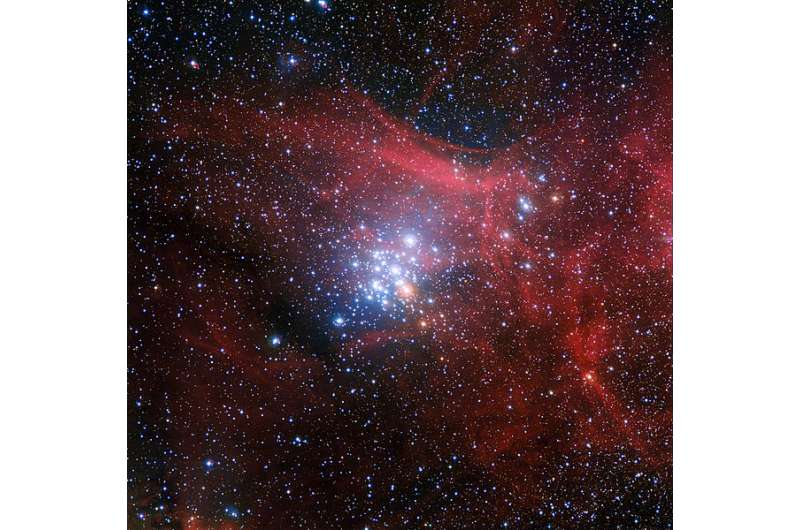August 2, 2017 report
Chandra observations provide insights about young stellar cluster NGC 3293

(Phys.org)—Observations conducted with NASA's Chandra X-ray Observatory have uncovered a young stellar cluster designated NGC 3293. The data provided by the spacecraft reveal insights about its stellar population. The findings were presented July 27 in a paper published on arXiv.org.
Located some 8,000 light years away from the Earth, NGC 3293 is a young open cluster at the northwestern periphery of the Carina Nebula Complex (CNS). It is known for its impressive collection of bright stars, including 48 early B-type stars. Although NGC 3293 is a very prominent celestial object, it is the only cluster in the CNC that had not yet been observed in X-rays. The cluster was often neglected in studies of the Carina Nebula Complex due to its angular separation of about 230 light years from the center of the CNC.
This situation changed when a group of researchers led by Thomas Preibisch of the Ludwig-Maximilian University of Munich in Germany carried out the first X-ray monitoring of NGC 3293 with Chandra in October 2015. These observations resulted in the detection of more than 1,000 individual X-ray point sources, allowing the team to better characterize the stellar population of the cluster.
"We have performed the first deep X-ray observation of the young cluster NGC 3293 at the northwestern edge of the Carina Nebula Complex. (...) The present study is the first where NGC 3293 is investigated in the same way as all other clusters in the CNC (i.e., by a combination of a deep X-ray and infrared data)," the researchers wrote in the paper.
According to the study, NGC 3293 contains about 3,600 stars, which makes it one of the most populous clusters in the entire Carina Nebula Complex. Notably, the cluster has a large population of low-mass stars (below two solar masses), which refutes previous claims of a lack of solar-mass stars in NGC 3293.
Despite its relatively young age of about eight to 10 million years old, NGC 3293 is the oldest of the large clusters in the CNC. The researchers found that the studied cluster probably contained several O-type stars during its first two million years after formation. They assume that supernova explosions of these O-type stars may have played an important role in the process of evolution of the entire Carina Nebula Complex.
"Our data shows that NGC 3293 is one of the most populous stellar clusters in the entire Carina Nebula Complex (very similar to Tr 16 and Tr 15; only Tr 14 is more populous). The cluster probably harbored several O-type stars, whose supernova explosions may have had an important impact on the early evolution of the Carina Nebula Complex," the authors wrote in the paper.
In concluding remarks, the scientists emphasized the importance of their research. They noted that studies based on a good characterization of the ages and stellar populations of clusters are crucial for understanding the "intricate spatio-temporal progression" of star formation in huge cloud complexes.
More information: Chandra X-ray observation of the young stellar cluster NGC 3293 in the Carina Nebula Complex, arXiv:1707.08782 [astro-ph.SR] arxiv.org/abs/1707.08782
Abstract
We characterize the stellar population of the poorly explored young stellar cluster NGC 3293 at the northwestern periphery of the Carina Nebula Complex, in order to evaluate the cluster age and the mass function, and to test claims of an abnormal IMF and a deficit of M <= 2.5 M_sun stars. We performed a deep (70 ksec) X-ray observation of NGC 3293 with Chandra and detected 1026 individual X-ray point sources. We identify counterparts for 74% of the X-ray sources in deep near-infrared images. Our data clearly show that NGC 3293 hosts a large population of solar-mass stars, refuting claims of a lack of M <= 2.5 M_sun stars. The analysis of the color magnitude diagram suggests an age of ~8-10 Myr for the low-mass population of the cluster. There are at least 511 X-ray detected stars with color magnitude positions that are consistent with young stellar members within 7 arcmin of the cluster center. The number ratio of X-ray detected stars in the 1-2 M_sun range versus the M >= 5 M_sun stars (known from optical spectroscopy) is consistent with the expectation from a normal field initial mass function. Most of the early B-type stars and 20% of the later B-type stars are detected as X-ray sources. Our data shows that NGC 3293 is one of the most populous stellar clusters in the entire Carina Nebula Complex. The cluster probably harbored several O-type stars, whose supernova explosions may have had an important impact on the early evolution of the Carina Nebula Complex.
© 2017 Phys.org





















